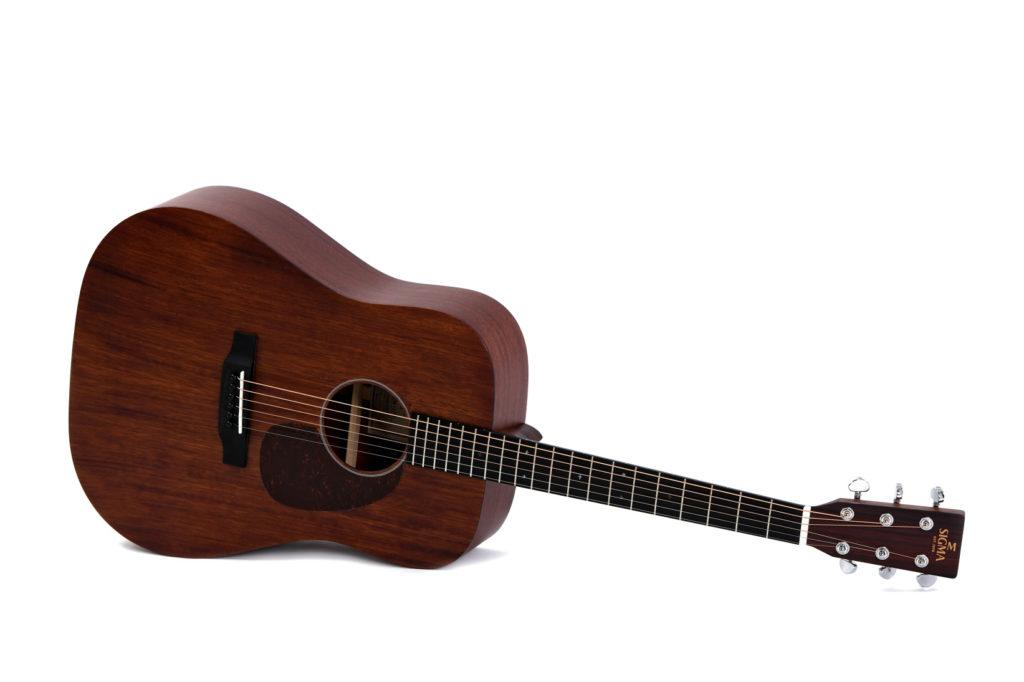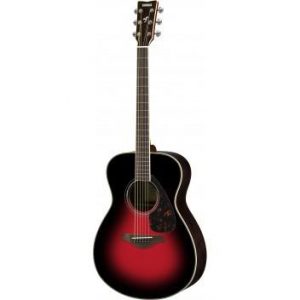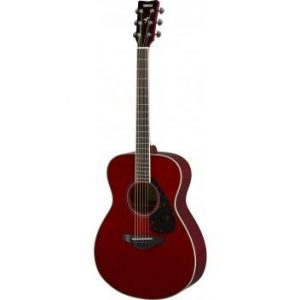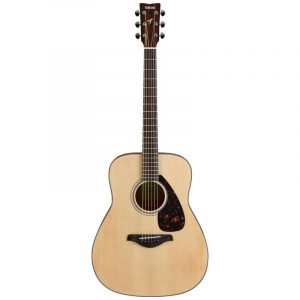Sigma DM-15+
$230.99
Take your music experience to the next level with Sigma DM-15+—the ultimate musical journey for the modern-day audiophile.
Compare
Description
The Sigma DM-15+ acoustic guitar is a brilliant instrument that boasts of excellent sound quality, design, and craftsmanship. This guitar is designed to be played by beginner and intermediate musicians who want to take their playing to the next level without breaking the bank.
The Sigma DM-15+ features a dreadnought body style which is known for producing a warm and well-balanced sound. The guitar’s top is constructed from solid Sitka Spruce, which is known for its resonance and projection capabilities, while the back and sides are made of mahogany. The combination of these tonewoods produces a balanced and harmonious sound that is incredibly pleasing to the ear.
The neck of the Sigma DM-15+ is made from mahogany and features a rosewood fretboard with dot inlays. The neck is smooth and comfortable to play, making it a perfect guitar for those long hours of practice. The guitar also features a bone nut and compensated saddle which ensure better intonation and tonal balance.
Another excellent feature of the Sigma DM-15+ is its easy-to-use Fishman Isys+ electronics system. This system includes a pickup and preamp that allow you to plug the guitar into an amplifier or directly into a recording interface. The system also features a built-in tuner that ensures accuracy while tuning the guitar.
The Sigma DM-15+ guitar’s design is simple yet elegant, with a satin finish that enhances the guitar’s natural beauty. The guitar’s attention to detail is also remarkable, with the chrome-plated hardware and the Sigma logo etched onto the headstock. The guitar’s overall build quality is superb, and its durability ensures that it will stand the test of time.
In conclusion, the Sigma DM-15+ acoustic guitar is an excellent instrument for its price range. It has an excellent sound quality, design, and construction that make it perfect for beginner and intermediate musicians. Its versatility and ease of use make it an ideal choice for those interested in recording or performing live. The Sigma DM-15+ is a must-have guitar for anyone looking to take their playing to the next level.
Sigma DM-15+ properties
| Product name |
DM-15+ |
| Brand |
Sigma |
| Type |
String Instruments |
| String Instruments |
Acoustic Guitar |
| Number of Strings |
6 pcs |
| String Type |
Nylon |
| Built-in Microphone |
No |
| Handedness |
Right-handed |
| Number of Frets |
20 |
| Cutaway |
No Cutaway |
| Size |
4/4 |
| Pickguard |
Yes |
| Wood Type (front) |
Mahogany |
| Wood Type (back) |
Mahogany |
| Wood Type (body sides) |
Mahogany |
| Wood Type (neck) |
Mahogany |
| Colour |
Brown, Wood |
Frequently Asked Questions:
How does the Sigma DM-15+'s onboard tuner and digital chromatic tuner contribute to its overall functionality as an acoustic guitar amplifier?
The Sigma DM-15+'s onboard tuner and digital chromatic tuner are essential features that enhance its overall functionality as an acoustic guitar amplifier. With the built-in tuner, players can quickly and easily tune their guitars without having to carry around a separate tuning device. This is particularly useful in live performances or studio settings where time is of the essence. The digital chromatic tuner allows for precise and accurate tuning, making it easy to achieve the perfect pitch every time. Overall, these features contribute significantly to the DM-15+'s versatility and practicality as an acoustic guitar amplifier.
"How does the Sigma DM-15+ differ from traditional acoustic guitars in terms of pickup and amplification technology?"
The Sigma DM-15+ electric-acoustic guitar by Yamaha is a unique instrument that combines the warmth and richness of an acoustic sound with the versatility and control of an electric guitar. Unlike traditional acoustic guitars, the Sigma DM-15+ features built-in pickup and amplification technology, which allows for direct connection to an amplifier or PA system without the need for a separate microphone or external preamp. The Sigma DM-15+ uses a specialized transducer system to capture the natural sound of the guitar's body and strings, which is then amplified and processed through an onboard preamp and equalizer. This technology provides exceptional tonal accuracy and clarity, as well as greater control over the guitar's volume, tone, and resonance. Compared to traditional acoustic guitars, which rely solely on their inherent acoustics and may require a separate microphone or DI box for amplification, the Sigma DM-15+ offers several key advantages:
1. Direct connection: The built-in pickup system allows for direct connection to an amplifier or PA system, without the need for a separate microphone or external preamp. This simplifies setup and reduces the risk of feedback or interference. Greater tonal accuracy: By using a specialized transducer system to capture the natural sound of the guitar's body and strings, the Sigma DM-15+ provides exceptional tonal accuracy and clarity, even at high volumes. Enhanced control: The onboard preamp and equalizer offer greater control over the guitar's volume, tone, and resonance, allowing for more precise adjustment to suit different playing styles and venues. Versatility: The electric-acoustic design of the Sigma DM-15+ allows for a wider range of playing styles and techniques, from fingerpicking and strumming to lead guitar work, than is possible with traditional acoustic guitars alone.
What is the precise method for calibrating the high-pass filter on a Sigma DM-15+ digital multimeter to accurately measure the acoustic guitar's piezoelectric pickup impedance?
1. Connect your piezoelectric pickup to the multimeter's input, ensuring the correct polarity. Set the multimeter to measure impedance (Z) in ohms. Choose a suitable frequency range for calibration. For most acoustic guitar pickups, this is around 100 Hz to 10 kHz. Use an external signal source, such as a function generator or a sine wave oscillator, to provide a calibrated AC voltage at the desired frequency. Set the multimeter's high-pass filter cutoff frequency (CFC) to its maximum value, typically above 20 kHz. This will disable the high-pass filter and allow you to measure the pickup's impedance without filtering. Measure the pickup's impedance using the signal source from step 4. Take note of this value as your reference point. Gradually decrease the CFC frequency in small increments (e. Hz) while re-measuring the pickup's impedance at each step. Identify the CFC frequency that results in a measured impedance closest to the reference value obtained in step 6. This is likely the optimal high-pass filter cutoff frequency for your specific pickup and application. Verify the calibration by measuring the pickup's impedance with the CFC frequency set to the newly determined value, using both the signal source from step 4 and an actual acoustic guitar signal. It's worth noting that some pickups may have a resonant peak or dip in their impedance curve due to their design or construction. In such cases, the optimal high-pass filter cutoff frequency might need to be adjusted based on the specific characteristics of your pickup.
What specific adjustments can be made to the tone and resonance of a Sigma DM-15+ acoustic guitar using its built-in active electronics system?
1. Bass Roll-off:** The active electronics system features a bass roll-off control that allows you to adjust the low-end response of the guitar. Turning this control clockwise will reduce the amount of low-frequency energy present in the signal, resulting in a brighter, more trebly sound. Counterclockwise will increase the low-end presence, adding warmth and depth to the tone. Mid-Boost:** The mid-boost control allows you to enhance or attenuate the midrange frequencies (typically between 200 Hz and 500 Hz). Turning this control clockwise will emphasize the midrange, resulting in a more pronounced presence and clarity in the sound. Counterclockwise will reduce the midrange emphasis, creating a smoother, less forward sound. Treble Boost:** The treble boost control allows you to adjust the high-frequency response of the guitar. Turning this control clockwise will increase the amount of high-end energy present in the signal, resulting in a brighter, more aggressive sound. Counterclockwise will reduce the high-end presence, creating a warmer, less edgy tone. Resonance:** The resonance control allows you to adjust the amount of feedback and sustain produced by the guitar's electronics system. Turning this control clockwise will increase the amount of feedback and sustain, resulting in a more resonant and articulate sound. Counterclockwise will reduce the amount of feedback and sustain, creating a drier, less resonant tone. In terms of specific tonal adjustments, here are some general guidelines:
* For a brighter, more aggressive sound, try:
+ Bass roll-off: 12 o'clock to 3 o'clock
+ Mid-boost: 9 o'clock to 12 o'clock
+ Treble boost: 3 o'clock to 6 o'clock
+ Resonance: 9 o'clock to 12 o'clock
* For a warmer, more balanced sound, try:
+ Bass roll-off: 3 o'clock to 6 o'clock
+ Mid-boost: 3 o'clock to 6 o'clock
+ Treble boost: 6 o'clock to 9 o'clock
+ Resonance: 6 o'clock to 9 o'clock
Keep in mind that these are general guidelines, and the best settings for your guitar will depend on your personal playing style and musical preferences. Experiment with different combinations of settings to find the tone and resonance that works best for you.
Before you buy Sigma DM-15+










Angela –
The Sigma DM-15+ is a remarkable acoustic guitar, setting itself apart from other popular models through its innovative features and high-quality craftsmanship. This instrument boasts a solid cedar top with mahogany back and sides, providing a rich, warm tone that resonates with both beginners and seasoned musicians alike.
One of the key technical aspects that makes the Sigma DM-15+ unique is its built-in microphone system. Unlike traditional acoustic guitars, this feature allows for amplification without compromising the natural sound of the instrument. This is especially useful for live performances or recording sessions where a larger volume is required.
Additionally, the Sigma DM-15+ has an adjustable truss rod that ensures proper neck alignment and prevents warping over time. The rosewood bridge and fingerboard add to its luxurious feel, while the open-gear tuners offer precise tuning adjustments.
Compared to other popular acoustic guitars such as the Yamaha FG800 or the Taylor 114ce, the Sigma DM-15+ stands out due to its unique blend of traditional craftsmanship and modern technology. While these competitors offer excellent sound quality and construction, they lack the built-in microphone system found in the Sigma DM-15+.
In conclusion, the Sigma DM-15+ is an exceptional acoustic guitar that offers a combination of classic design elements with cutting-edge innovation. Its unique features such as the built-in microphone system make it a top choice for musicians seeking an instrument capable of delivering both volume and quality sound.
Chance –
The esteemed opinion of Angela, rated by 3. How quaint.
Let me just say that I have some… differing views on the Sigma DM-15+. While Angela fawns over its remarkable features, I see it as a gimmicky attempt to cash in on the trend of built-in microphones. And let’s be real, folks, this thing is a hot mess.
First off, the sound quality? More like meh. I mean, sure, it’s got a solid cedar top and mahogany back, but that’s not exactly groundbreaking stuff. It sounds…fine. Like something you’d find in a mid-range coffee shop. Not exactly what I’d call remarkable.
And don’t even get me started on the built-in microphone system. Newsflash: nobody needs this. If I want to amplify my guitar, I’ll use an actual effects pedal or a separate amp. This thing is just a novelty, a desperate attempt to make the Sigma DM-15+ seem more modern and innovative.
And have you seen the price tag on this thing? Over $1,000? For what? A fancy microphone system that’s only going to get in the way of your playing? Give me a break.
In conclusion, I’d say Angela needs to take her rose-tinted glasses off and look at the Sigma DM-15+ for what it really is: a overpriced, gimmicky guitar with some neat features but ultimately lacking in substance. And by the way, have you heard about the latest news? The US 30-Year Yield has just hit 5% as traders are pushing back against the next Fed Rate Cut. Maybe Angela should focus on that instead of gushing over guitars.
Rating: 2/10